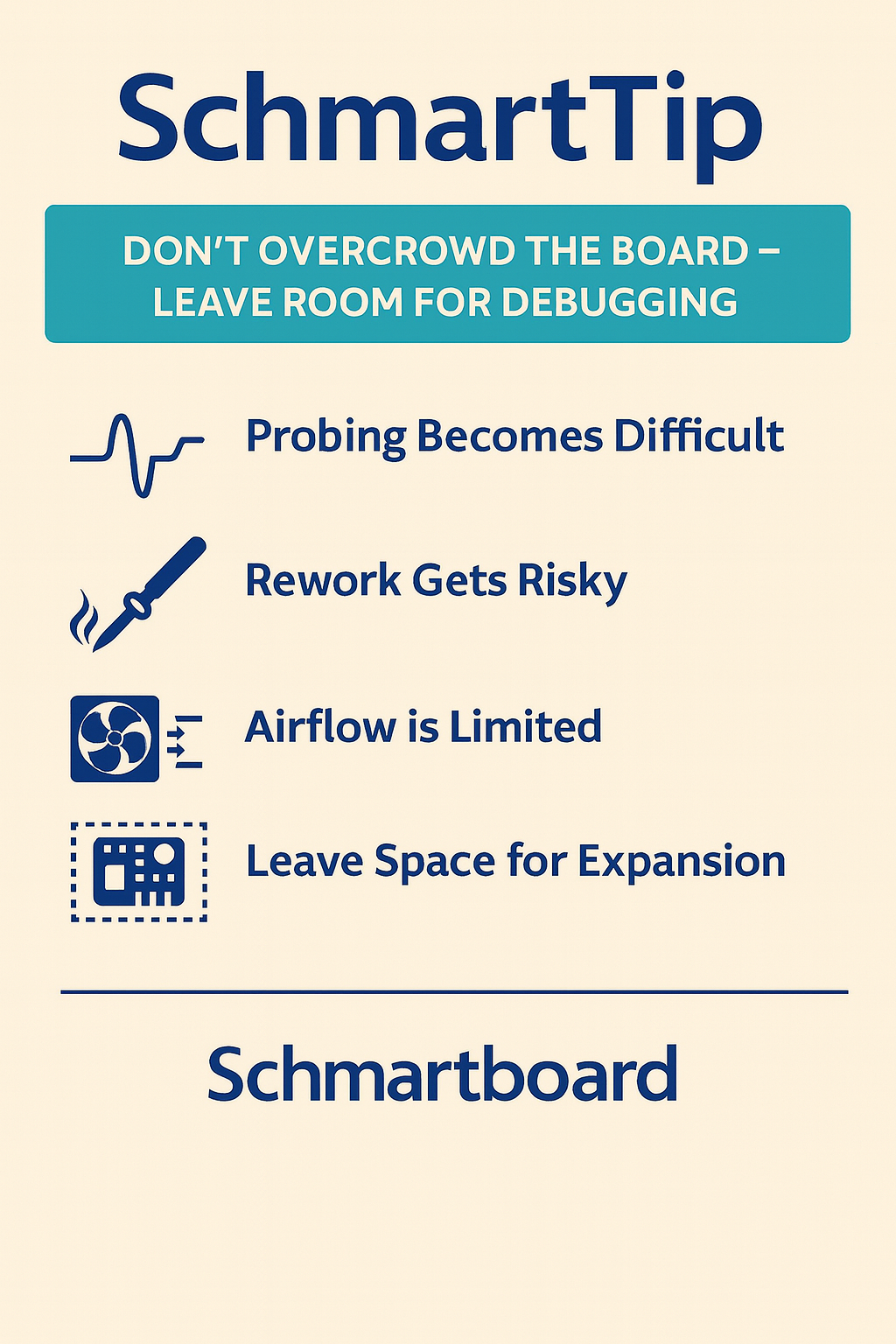 Loading... Please wait...
Loading... Please wait...Categories
Don’t Overcrowd the Board — Leave Room for Debugging
Posted by Schmartboard on Sep 27th 2025
When designing a printed circuit board (PCB), it’s tempting to use every bit of available space. After all, shrinking the board size can reduce costs and make your design look sleek and efficient. But here’s the reality: overcrowding your board is a recipe for frustration when it comes time to test, debug, and modify your circuit.
One of the golden rules of PCB design is simple:
Don’t overcrowd the board — leave room for debugging.
Why Space Matters in PCB Design
When components are packed too tightly:
-
Probing Becomes Difficult – Oscilloscope probes, multimeter leads, or logic analyzer clips may not fit between closely placed pins or traces.
-
Rework Gets Risky – Soldering or desoldering individual components without disturbing neighbors becomes nearly impossible.
-
Airflow is Limited – Components that generate heat can overheat faster when airflow around them is restricted.
-
Signal Crosstalk Increases – Tight layouts without spacing can cause unintended coupling between traces, leading to noise issues.
Simply put, a board with zero breathing room might work fine in theory — but in practice, it becomes a nightmare to troubleshoot.

Design With Debugging in Mind
Here are some best practices:
-
Leave Test Pads and Access Points
Add small test pads for key signals so you can easily connect probes during debugging. -
Group Components by Function
Keep related parts together but leave margins between groups. This helps you quickly isolate issues. -
Use Silkscreen Labels Generously
Clear labels for pins, test points, and component values make debugging faster and less error-prone. -
Plan for Expansion or Rework
Reserve a little extra room for jumper wires, alternative components, or bodge fixes if needed.
How Schmartboard Helps
At Schmartboard, we know that rapid prototyping often involves iterating and debugging. That’s why our prototyping solutions are designed with extra space and accessible layouts.
-
Our boards are engineered to make soldering easier, which is critical when you’re replacing or reworking parts.
-
They provide room to probe signals, add jumpers, or insert test components without crowding.
-
Schmartboard layouts often mimic best practices from professional PCB design, making the transition from prototype to production smoother.
By starting your design with Schmartboard, you give yourself the breathing room you’ll need when something doesn’t go as planned (because in prototyping, that’s almost guaranteed!).
Final Thoughts
A successful PCB design isn’t just about making it small or efficient — it’s about making it workable, testable, and repairable. Leaving room for debugging ensures that when issues arise, you can solve them without tearing your hair out.
With Schmartboard, you get prototyping tools that respect this principle, helping you create boards that aren’t just functional, but also practical to work with.
So remember: Don’t overcrowd the board — leave space to debug, and design smarter with Schmartboard.
Recent Posts
- » Do Inspect Solder Joints Under Magnification for Intermittent Issues
- » Don’t Assume Power Supplies Are Perfectly Clean
- » Do Choose the Right PCB Stack-Up Early to Support Signal Integrity
- » Do Route High-Frequency Signals with Controlled Impedance
- » Don’t Overcrowd the Board — Leave Room for Debugging
